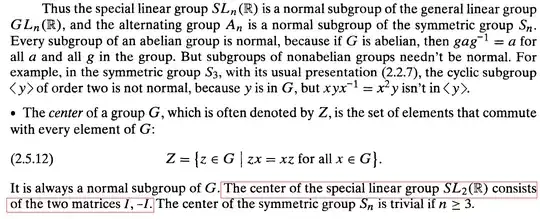Algebra by Michael Artin Def 2.5.12
Obviously $I$ and $-I$ are in the centre: $AI=IA,A(-I)=(-I)A$.
How exactly do I go about doing this?
I was thinking to solve for $j,f,g,h$ below
$$\begin{bmatrix} a & b\\ c & d \end{bmatrix} \begin{bmatrix} j & f\\ g & h \end{bmatrix} = \begin{bmatrix} j & f\\ g & h \end{bmatrix} \begin{bmatrix} a & b\\ c & d \end{bmatrix}, ad-bc=1=jh-fg.$$
So, I plug in b*g=c*f, a*f+b*h=b*j+d*f, c*j+d*g=a*g+c*h, j*h-f*g=1, a*d-b*c=1 in Wolfram Alpha or here or here (or here) to get a bunch of complicated solutions sets, some of which include the desired $\pm I$.
Ugh, where can I find a proof online?
Or if this is still folklore, how do I begin?
Do I for example take cases $c=0, c \ne 0$ and then solve for the centre in each case('s subcases)?
Another thing I thought was to suppose on the contrary that $f \ne 0$ and then arrive at a contradiction and then assume $f=0$ when supposing on the contrary that $g \ne 0$ and then assuming $f=g=0$ when supposing on the contrary that $j \ne \pm 1$ and then assuming $f=g=0, j = \pm 1$ when supposing on the contrary that $h \ne \pm 1$.
Not looking for a full solution, just a little nudge in the right direction. I've been lost in subcases of subcases of cases (like here) that I think I'm missing something elegant or simple. I guess I've been doing maths for quite awhile that I've forgotten how to do arithmetic.
To clarify, I am looking for a way to do this by systems or at least nothing high level like using facts like these About the Center of the Special Linear Group $SL(n,F)$ Note that this chapter is on homomorphisms. The reader just finished cyclic groups. The reader didn't reach Lagrange's Theorem, fields, rings or even isomorphisms.
